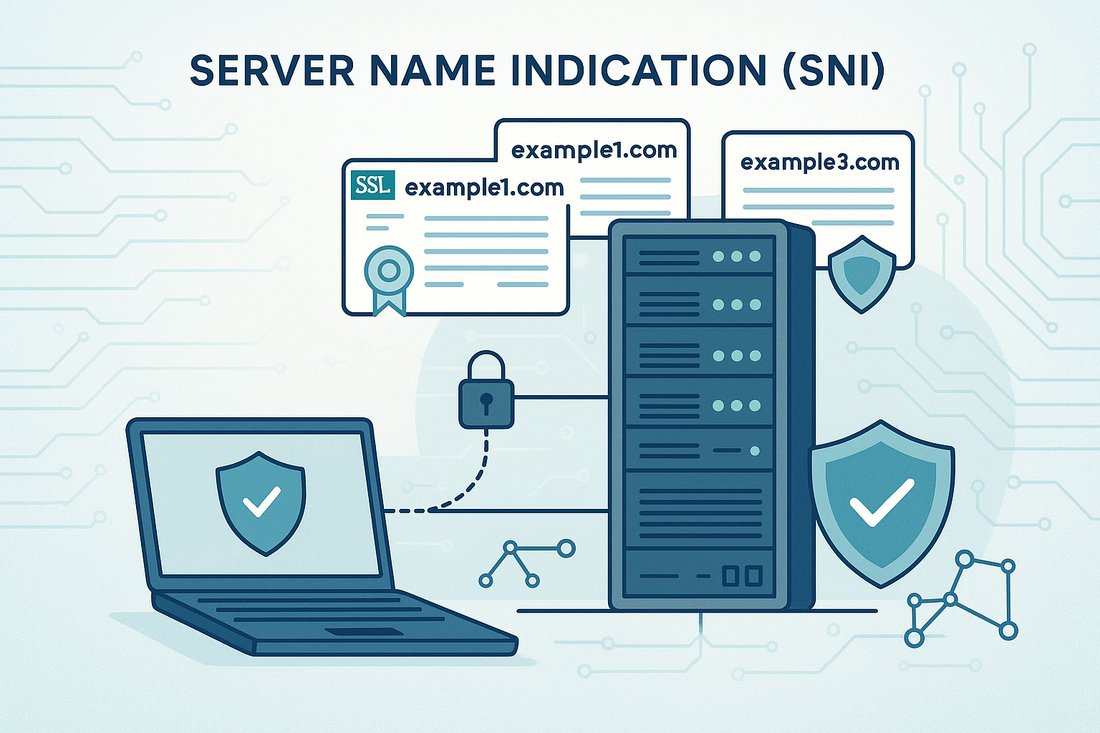
What is Server Name Indication (SNI)
Kevin TaylorShare
Server Name Indication (SNI) represents a crucial advancement in SSL Certificate technology, enabling multiple secure websites to share a single IP address while maintaining proper SSL Certificate validation.
This extension to the Transport Layer Security (TLS) protocol has revolutionized how web servers handle HTTPS connections, making secure hosting more efficient and cost-effective for businesses of all sizes.
Understanding Server Name Indication
Before SNI emerged, web servers required dedicated IP addresses for each SSL Certificate installation.
This limitation stemmed from the SSL Certificate/TLS handshake process, where the server needed to present the correct SSL Certificate before knowing which hostname the client was attempting to access.
This traditional approach led to IP address exhaustion and increased hosting costs for organizations managing multiple secure websites.
SNI solved this challenge by allowing the client (typically a web browser) to specify the intended hostname during the initial TLS handshake.
This crucial piece of information enables the server to select and present the appropriate SSL Certificate for the requested domain, even when multiple domains share the same IP address.
How SNI Works
The SNI process begins during the TLS handshake, specifically in the ClientHello message.
When a browser initiates a secure connection to a website, it includes the target hostname in this initial communication.
The web server then uses this information to select the correct SSL Certificate from its SSL Certificate store and proceeds with the secure connection establishment.
Technical Implementation
The SNI extension operates as part of the TLS protocol, requiring support from both the client and server sides.
Modern web servers like Apache, Nginx, and Microsoft IIS include built-in SNI support. The configuration typically involves setting up virtual hosts or server blocks, each with its own SSL Certificate configuration.
Benefits of SNI Technology
SNI offers significant advantages for website operators and hosting providers. The ability to host multiple SSL Certificate-secured websites on a single IP address reduces infrastructure costs and simplifies SSL Certificate management.
This efficiency becomes particularly valuable in shared hosting environments where hundreds or thousands of websites may require secure HTTPS connections.
Cost Reduction
By eliminating the need for dedicated IP addresses, SNI helps organizations optimize their hosting expenses.
This cost benefit extends to both small businesses running multiple secure sites and large enterprises managing extensive web infrastructures. The savings can be substantial, especially considering the increasing scarcity and cost of IPv4 addresses.
Compatibility Considerations
While SNI support is nearly universal in modern systems, some legacy clients and older operating systems may not support this technology.
Windows XP with Internet Explorer, for instance, cannot properly handle SNI connections. However, these legacy systems represent an increasingly small percentage of web traffic, making SNI a reliable solution for most contemporary deployments.
Browser Support
All major modern browsers, including Chrome, Firefox, Safari, and Edge, fully support SNI.
Mobile browsers on iOS and Android devices also implement SNI correctly, ensuring broad compatibility across different platforms and devices.
Implementation Best Practices
When implementing SNI on web servers, several best practices should be followed to ensure optimal security and performance.
Server administrators should maintain current versions of web server software and regularly update SSL Certificates to prevent security vulnerabilities.
Server Configuration
Proper server configuration involves setting up distinct virtual hosts for each domain, ensuring correct SSL Certificate paths, and maintaining proper file permissions.
Regular security audits help verify that all SSL Certificates remain valid and properly configured.
Troubleshooting SNI Issues
Common SNI-related issues often involve SSL Certificate mismatches or improper virtual host configurations.
When troubleshooting, administrators should verify that hostname matching is correct and that all necessary intermediate SSL Certificates are properly installed.
Server logs typically provide valuable information for diagnosing SNI-related connection problems.
Future of SNI Technology
As the internet continues to evolve, SNI technology remains crucial for secure web hosting. Emerging protocols like TLS 1.3 build upon SNI capabilities, offering enhanced privacy and security features.
The ongoing development of encrypted SNI (ESNI) promises to further improve privacy by preventing surveillance of SNI information during the TLS handshake.
Conclusion
Server Name Indication has become an indispensable component of modern web infrastructure, enabling efficient SSL Certificate deployment across multiple domains.
Understanding and implementing SNI correctly ensures optimal security while managing costs effectively.
Trustico® offers comprehensive SSL Certificate solutions that fully support SNI technology, helping organizations maintain secure and efficient web presence.
As the internet continues to emphasize security and privacy, SNI remains a fundamental technology for secure website hosting.



